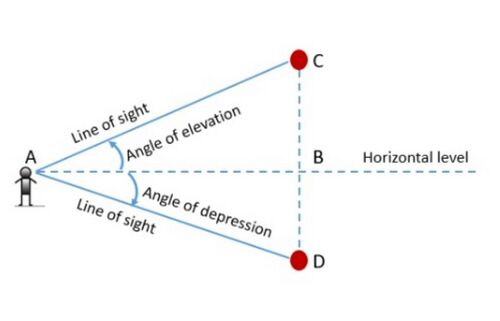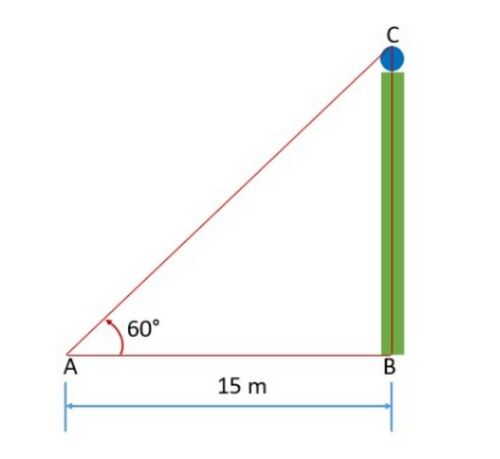ऊँचाइयाँ और दूरियाँ: Difference between revisions
(added content) |
(added content) |
||
| Line 7: | Line 7: | ||
[[File:Heights and Distances.jpg|alt=Fig. 1 - Heights and distances|thumb|500x500px|चित्र -1 ऊँचाइयाँ और दूरियाँ]] | [[File:Heights and Distances.jpg|alt=Fig. 1 - Heights and distances|thumb|500x500px|चित्र -1 ऊँचाइयाँ और दूरियाँ]] | ||
== | == दृष्टि-रेखा == | ||
पर्यवेक्षक की आंखों से वस्तु पर देखे जा रहे बिंदु तक खींची गई रेखा को दृष्टि-रेखा के रूप में जाना जाता है। | |||
== | == उन्नयन कोण == | ||
पर्यवेक्षक द्वारा देखी गई वस्तु (क्षैतिज स्तर से ऊपर) पर बिंदु का उन्नयन कोण वह कोण है जो क्षैतिज स्तर के साथ दृष्टि-रेखा द्वारा बनता है। | |||
== | == अवनमन कोण == | ||
पर्यवेक्षक द्वारा देखी गई वस्तु पर स्थित बिंदु (क्षैतिज स्तर से नीचे) का अवनमन कोण, दृष्टि-रेखा और क्षैतिज स्तर के बीच बनने वाला कोण होता है। | |||
== | == ऊँचाई और दूरियाँ कैसे ज्ञात करें == | ||
त्रिकोणमितीय अनुपात की सहायता से किसी वस्तु की ऊँचाई या लॅंबाई या दो दूर की वस्तुओं के बीच की दूरी निर्धारित की जा सकती है। | |||
For example, in fig.1, a person is looking at the top of the object. <math>AB</math> is horizontal level. This level is the line parallel to ground passing through the observer’s eyes. <math>AC</math> is known as the line of sight. <math>\angle CAB</math> is called the angle of elevation. Similarly, in fig. 1, person is looking down at a object. <math>AB</math> is horizontal level. This level is the line parallel to ground passing through the observer’s eyes. <math>AD</math> is known as the line of sight. <math>\angle BAD</math> is called the angle of depression. | For example, in fig.1, a person is looking at the top of the object. <math>AB</math> is horizontal level. This level is the line parallel to ground passing through the observer’s eyes. <math>AC</math> is known as the line of sight. <math>\angle CAB</math> is called the angle of elevation. Similarly, in fig. 1, person is looking down at a object. <math>AB</math> is horizontal level. This level is the line parallel to ground passing through the observer’s eyes. <math>AD</math> is known as the line of sight. <math>\angle BAD</math> is called the angle of depression. | ||
[[File:Heights and Distances - problem 1.jpg|alt=Fig. 2 - Problem|thumb|500x500px|Fig. 2 - Problem]] | [[File:Heights and Distances - problem 1.jpg|alt=Fig. 2 - Problem|thumb|500x500px|Fig. 2 - Problem]] | ||
''' | '''उदाहरण:''' A tower stands vertically on the ground. From a point on the ground, which is <math>15 </math>m away from the foot of the tower, the angle of elevation of the top of the tower is found to be <math>60^\circ</math>. Find the height of the tower. | ||
''' | '''हल:''' To solve the problem, we choose the trigonometric ratio <math>tan \ 60^\circ</math> (or <math>cot \ 60^\circ</math>), as the ratio involves <math>AB</math> and <math>BC</math> . | ||
<math>tan \ 60^\circ =\frac{BC}{AB}</math> | <math>tan \ 60^\circ =\frac{BC}{AB}</math> | ||
Revision as of 09:54, 15 June 2024
ऊँचाई और दूरियाँ का विषय त्रिकोणमिति के अनुप्रयोगों में से एक है, जिसका वास्तविक जीवन में व्यापक रूप से उपयोग किया जाता है। त्रिकोणमिति में ऊँचाई और दूरियाँ शब्दों का प्रायः उपयोग किया जाता है, जबकि इसके अनुप्रयोगों से आचरण किया जाता है। त्रिकोणमिति के ऊँचाई और दूरी के अनुप्रयोग में, निम्नलिखित अवधारणाएँ उपस्थित हैं:
- मीनारों(टावरों) की ऊँचाई मापना
- समुद्र से तट की दूरी निर्धारित करना
- दो खगोलीय पिंडों के बीच की दूरी ज्ञात करना
दृष्टि-रेखा
पर्यवेक्षक की आंखों से वस्तु पर देखे जा रहे बिंदु तक खींची गई रेखा को दृष्टि-रेखा के रूप में जाना जाता है।
उन्नयन कोण
पर्यवेक्षक द्वारा देखी गई वस्तु (क्षैतिज स्तर से ऊपर) पर बिंदु का उन्नयन कोण वह कोण है जो क्षैतिज स्तर के साथ दृष्टि-रेखा द्वारा बनता है।
अवनमन कोण
पर्यवेक्षक द्वारा देखी गई वस्तु पर स्थित बिंदु (क्षैतिज स्तर से नीचे) का अवनमन कोण, दृष्टि-रेखा और क्षैतिज स्तर के बीच बनने वाला कोण होता है।
ऊँचाई और दूरियाँ कैसे ज्ञात करें
त्रिकोणमितीय अनुपात की सहायता से किसी वस्तु की ऊँचाई या लॅंबाई या दो दूर की वस्तुओं के बीच की दूरी निर्धारित की जा सकती है।
For example, in fig.1, a person is looking at the top of the object. is horizontal level. This level is the line parallel to ground passing through the observer’s eyes. is known as the line of sight. is called the angle of elevation. Similarly, in fig. 1, person is looking down at a object. is horizontal level. This level is the line parallel to ground passing through the observer’s eyes. is known as the line of sight. is called the angle of depression.
उदाहरण: A tower stands vertically on the ground. From a point on the ground, which is m away from the foot of the tower, the angle of elevation of the top of the tower is found to be . Find the height of the tower.
हल: To solve the problem, we choose the trigonometric ratio (or ), as the ratio involves and .
Hence, the height of the tower is m.

